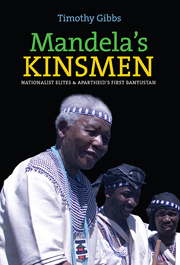Book contents
- Frontmatter
- Contents
- List of Maps and Figures
- Acknowledgements
- List of Abbreviations
- Introduction: Mandela' Kinsmen
- 1 Education, Monarchy & Nationalism
- 2 The First Bantustan, 1954–1963
- 3 The Second Peasants' Revolt, Mpondoland 1960–1980
- 4 The Old Mission Schools, 1963–1980
- 5 The Comrade-King, Bantustan Politics 1964–1980
- 6 Chris Hani's Guerrillas, 1974–1987
- 7 The Apartheid Endgame, 1987–1996
- 8 The New South Africa & Transkei's Collapse, 1990 onwards
- Conclusion: African Nationalism & its Fragments
- Bibliography
- Index
Introduction: Mandela' Kinsmen
Published online by Cambridge University Press: 05 April 2014
- Frontmatter
- Contents
- List of Maps and Figures
- Acknowledgements
- List of Abbreviations
- Introduction: Mandela' Kinsmen
- 1 Education, Monarchy & Nationalism
- 2 The First Bantustan, 1954–1963
- 3 The Second Peasants' Revolt, Mpondoland 1960–1980
- 4 The Old Mission Schools, 1963–1980
- 5 The Comrade-King, Bantustan Politics 1964–1980
- 6 Chris Hani's Guerrillas, 1974–1987
- 7 The Apartheid Endgame, 1987–1996
- 8 The New South Africa & Transkei's Collapse, 1990 onwards
- Conclusion: African Nationalism & its Fragments
- Bibliography
- Index
Summary
‘I was born on 18 July 1918 at Mvezo, a tiny village on the banks of the Mbashe River, in the district of Umtata, the capital of Transkei… a beautiful country of rolling hills, fertile valleys, and a thousand rivers and streams which keep the landscape green.’ The opening chapters of Nelson Mandela's autobiography give a lyrical account of his rural childhood. The Transkei territories are an area of scattered settlements and bustling small towns situated between the Indian Ocean and the Drakensberg mountains in the Xhosa-speaking, Eastern Cape region of South Africa. Mandela spent most of his early years at Qunu, a small settlement of beehive-shaped huts built with mud walls which ‘was situated in a narrow grassy valley crisscrossed by clear streams.’ Only the Christian converts wore Western-style clothing, he recalled; but there were two small primary schools in the area, as well as ‘a general store and a dipping tank to rid the cattle of ticks and diseases’.
Nelson Mandela was aged nine when his father died and the family was separated. Being from the royal clan, Mandela was placed under the protection of Jongitaba, the regent of the Thembu Kingdom. Here he was immersed in the court life at the Great Place of Mqhekezweni. The young Mandela was fascinated by the living customs of the Thembu kingdom: a whole chapter of his autobiography is spent describing the circumcision ceremony in the mountains that brought him into manhood at the age of sixteen. Afterwards, a sheep was slaughtered and he was taken in the regent's car to one of the most prominent boarding schools in Transkei: Clarkebury College, run by missionaries whose institutions were dotted across South Africa's ‘Native Reserves’.
- Type
- Chapter
- Information
- Mandela's KinsmenNationalist Elites and Apartheid's First Bantustan, pp. 1 - 9Publisher: Boydell & BrewerPrint publication year: 2014



